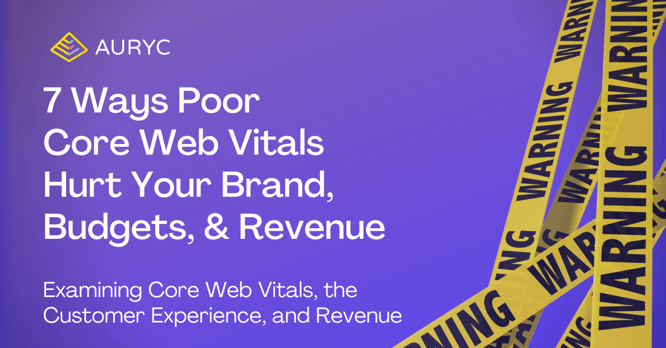7 Ways Poor Core Web Vitals Hurt Your Brand, Budgets, and Revenue

This article is part of a series of articles about Core Web Vitals.
“...a low Core Web Vitals score is a wake up call about your online customer experience.”
What does Google’s Core Web Vitals update mean for the online customer experience, brand, and revenue? More than you realize...
With up to 85% of sites currently failing to achieve a passing score for their Core Web Vitals, obviously we have not been taking page experience as seriously as we should. Afterall, Google Page Experience update in June 2021 zeroes in on the above mentioned metrics that focus on actual page experience… from image load times, to the speed that buttons and clicks execute, and even to that annoying problem of content shifting when assets like images, ads, and videos actually load on the page.
Instead of a bot crawling a site that force SEO “gurus” to mandate little tricks and hacks to rank higher based on content, Core Web Vitals are measured within the browser itself (ie, Chrome). As the page is loading and rendering, your browser is storing this info and sending it back to Google to report on your site’s pages. Every time a page loads, this information is aggregated to build an average Core Web Vitals score that Google then uses as part of its page ranking algorithm. (Yes, content is king, but now Google is making sure we know that user experience is queen.)
“Google is making sure we know that while content may be king, user experience is Queen.”
With Google emphasizing Page Experience more than ever… and even giving you the resources to test and benchmark your pages… it’s time to take your customer’s on-page experience more seriously. Or face the consequences…
We won’t go into the details of what Core Web Vitals actually are or what causes low Core Web Vitals scores. (You can check out more about those topics in our series on Core Web Vitals.)
What does a low (or non-passing) Core Web Vitals score mean for your site?
1. Poor Customer ExperienceIf you think you have issues now with your page experience, checkout experience, etc, it will become worse in the eyes of your customers. How? If other brands/companies are improving their onsite page experience so that they receive passing Core Web Vitals scores, your site will look less appealing now. Your customers will get MORE impatient waiting for items to load. They will get MORE frustrated with slow to execute clicks/button presses. They will get LESS tolerant of content reflowing on a page, even if there is some cool video or graphic your team spent weeks creating. (And if you have ads on your pages that cause re-flows of content, your consumers will bounce faster.) The bar is being raised all around you. Don’t be caught playing limbo… rise above the bar.
2. Lower ranking in search engines
Google will prioritize sites that have passing scores in search results. Yes, Page Rank still matters...it always will. And falling off the first page or two relegates your brand to a purgatory-like place that makes it less likely for consumers to find you and your products. SEO suffers and then you witness lower traffic.
By not having one of the premier spots in search results, you get fewer clicks… fewer clicks means less people coming to your site. This cascade continues further into many facets of your company outlined below. Like increased costs for traffic.
4. Increase in Costs for Paid Traffic
Whether you rely on a high amount of organic (which you better start taking Core Web Vitals VERY seriously) or you rely on a blend of organic and paid traffic, you WILL have to increase your budgets/spend to try to get some of that traffic back. Paid Search is already competitive and expensive, now imagine an even more competitive bidding environment. Like any “auction”, the prices go up for the clicks you ALREADY pay for, and since you need to rely on paid even more now, you need to get more of those expensive clicks. Coupling all of the above, you then start seeing the real damage - your bottom line.
5. Decrease in Revenue
Less traffic, fewer consumers, fewer shopping carts, fewer checkouts, less revenue. It’s not rocket science. This avalanche of bad news hits the bottom line, fast. Boom. And as revenue suffers and customers take their spending power elsewhere you lose market share.
6. Long-Term Loss of Market Share
If consumers are not coming to your site, they are going somewhere else...and spending there. Traffic declines, brand declines, revenue declines, and the revenue and profits of your competitors increase. You lose market share...it’s a silent drip that can make brands obsolete - maybe not in weeks, but in months and years. And with all of this damage, you will whittle away at your brand reputation that you have worked so hard to build.
7. Poor Brand Reputation
Once you get known for a poor online customer experience (no matter how good your customer support team is), word will spread. A clunky site, a slow(er) site, or even just one where a “favorite” or “add to wishlist” button is slow to respond will lower your favor with your customers. (you may have not changed ANYTHING and thought you were “fine”, but if they experience a better time on another site, it reflects negatively on you. Social media is a double edged sword for companies and your customers will talk (Facebook, Twitter, TikTok, LinkedIn, Reddit, Quora… anywhere a conversation is happening online, people talk about poor experiences much more than good ones.) A consumer’s knee-jerk reaction is to go to social media to complain more than ever. And once it is posted, it will live forever in some way… and erode at your brand reputation.
How to Avoid Low Core Web Vital Scores?
To help you, we wrote full articles on how to diagnose, understand why it happens, and how to fix your Core Web Vitals. It’s a big task, especially if you have thousands of pages, however, it is manageable with a few tips we’ve outlined in our previous articles:
- Form Your Team
- Document Everything
- Test Everything
- Improve Your Product, Continuously
Next steps after tackling your Core Web Vitals scores...
Low Core Web Vitals scores are a warning sign to you about your online customer experience.
And these are just scratching the surface...Other issues will exist below the surface that you aren’t even aware of yet. These issues cause you to miss out on potentially millions in lost revenue.
Use this Google algorithm update as a chance to review your customer experience beyond just Core Web Vitals.
Look at session replays, review error logs, conduct more post-purchase surveys, dive into your NPS scores (in the context of what that person’s experience actually was on site), and, if you have a website and mobile app, it’s time to look at your cross-device customer experience as well. Connect all of your customer experience data so you can see it holistically, not in detached silos that create and force you to ignore our data blind spots.
Core Web Vitals are just the beginning...Your customer experience is the new competitive edge.

%20(2).png?width=1200&name=Blog%20Featured%20Image%20for%20Social%20-%20Core%20Web%20Vitals-p1a%20(2)%20(2).png)
